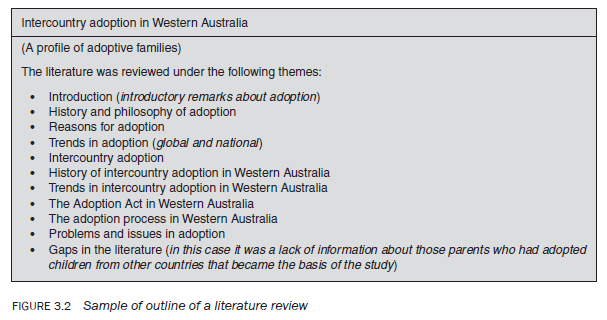Now, all that remains to be done is to write about the literature you have reviewed. As mentioned in the beginning of this chapter, two of the broad functions of a literature review are (1) to provide a theoretical background to your study and (2) to enable you to contextualise your findings in relation to the existing body of knowledge in addition to refining your methodology. The content of your literature review should reflect these two purposes. In order to fulfil the first
purpose, you should identify and describe various theories relevant to your field; and specify gaps in existing knowledge in the area, recent advances in the area of study, current trends and so on. In order to comply with the second function you should integrate the results from your study with specific and relevant findings from the existing literature by comparing the two for confirmation or contradiction. Note that at this stage you can only accomplish the first function of the literature review, to provide a theoretical background to your study. For the second function, the contextu- alisation of the findings, you have to wait till you are at the research report writing stage.
While reading the literature for theoretical background of your study, you will realise that certain themes have emerged. List the main ones, converting them into subheadings. Some people write up the entire literature review in one section, entitled ‘Review of the literature’, ‘Summary of literature’ or ‘The literature review’, without subheadings, but the author strongly suggests that you write your literature review under subheadings based upon the main themes that you have discovered and which form the basis of your theoretical framework. These subheadings should be precise, descriptive of the theme in question and follow a logical progression. Now, under each subheading, record the main findings with respect to the theme in question (thematic writing), highlighting the reasons for and against an argument if they exist, and identifying gaps and issues. Figure 3.2 shows the subheadings used to describe the themes in a literature review conducted by the author for a study entitled ‘Intercountry adoption in Western Australia’.

The second broad function of the literature review — contextualising the findings of your study — requires you to compare very systematically your findings with those made by others. Quote from these studies to show how your findings contradict, confirm or add to them. It places your findings in the context of what others have found out providing complete reference in an acceptable format. This function is undertaken, as mentioned earlier, when writing about your findings, that is after analysis of your data.
Source: Kumar Ranjit (2012), Research methodology: a step-by-step guide for beginners, SAGE Publications Ltd; Third edition.

You are my inhalation, I possess few web logs and occasionally run out from to brand.